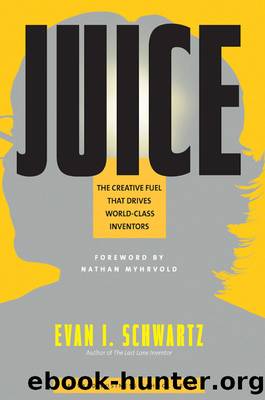Juice: The Creative Fuel That Drives World-Class Inventors by Evan I. Schwartz

Author:Evan I. Schwartz [Schwartz, Evan I.]
Language: eng
Format: epub
Tags: Business, Creativity, Economics, Inventors, Non-Fiction, Research & Development
ISBN: 9781422184066
Google: hKj-Utb21iUC
Amazon: B005HBYT7C
Publisher: Harvard Business Press
Published: 2004-08-31T23:00:00+00:00
REACHING INTO HISTORY
This behavior—of moving from base to target and sometimes back and forth repeatedly—reaches far back into history. Leonardo da Vinci, for example, observed that birds, when they spread their wings, used the air as a “wedge to raise them up.” He used the mechanical concept of a wedge as the base to understand behavior in the natural world. In turn, he used the flight of birds as the base to conceive of his target: a flying machine. Brainstorming an example of a rotating wedge, da Vinci conceived of a mechanical analogy: that of a screw boring into wood, lifting material out of the way as it turns. From that observation, he conceived of an “air screw.” His famous sketches of a helicopter-like apparatus feature screw-like rungs lifting a cone-shaped basket into the air. “If this instrument made with a screw . . . [is] turned swiftly,” he wrote, “the said screw will make its spiral in the air and it will rise high.”5
Da Vinci’s conception of an air screw as a flying machine was unworkable, but it was a breakthrough analogy nonetheless. It would be left to future inventors to conceive of an even better analogy, that of a rotary wing, a concept that led to the development of the propeller.
Johannes Gutenberg, by contrast, was able to put his analogy into practice. Gutenberg, a fifteenth-century German metalworker, was searching for a system for mass-producing the Bible. At that time, monks hand-carved wooden plates for each page they wanted to print. They inked the plate, laid a piece of paper on it, and rubbed it until an impression was made. It beat copying manuscripts by hand, but it wasn’t an efficient way to reproduce books. Although the Chinese are known to have invented movable type earlier, Gutenberg didn’t know about it. He set out to reinvent aspects of printing, as often happens in the world of invention.
In his revolutionary creation of a printing press, Gutenberg applied two analogies. He took the first one from the stamps and wax seals used for embossing emblems or characters on paper. He saw that if he were to line up many of these stamps in rows, he’d be able to rearrange and reuse them. When he miniaturized the characters and fashioned them out of metal that could be positioned in rows, he became the first European known to create movable type.
What remained was to replace hand rubbing with a way of rapidly printing page after page from the same plate. Gutenberg stumbled into this more interesting analogy at a wine festival. There, amid the drunken revelry, he saw a hand-cranked winepress that was used to extract juice from flat beds of grapes. That was the inspiration for creating a hand-cranked machine that rapidly pressed blank pages against a flat bed of easily arranged characters.6 Nearly six centuries later, we use that analogy every time we refer to the media as “the press.”
Gutenberg’s isn’t the only media invention that originated from analogies that recall the world of agriculture.
Download
This site does not store any files on its server. We only index and link to content provided by other sites. Please contact the content providers to delete copyright contents if any and email us, we'll remove relevant links or contents immediately.
| Direct | Global |
| Industrial | Multilevel |
| Product Management | Research |
| Telemarketing | Web Marketing |
Influence: The Psychology of Persuasion by Robert B. Cialdini(4173)
The Miracle Morning by Hal Elrod(3903)
The Hacking of the American Mind by Robert H. Lustig(3575)
Pre-Suasion: A Revolutionary Way to Influence and Persuade by Robert Cialdini(3404)
Unlabel: Selling You Without Selling Out by Marc Ecko(2975)
Hidden Persuasion: 33 psychological influence techniques in advertising by Marc Andrews & Matthijs van Leeuwen & Rick van Baaren(2771)
Who Can You Trust? by Rachel Botsman(2729)
Kick Ass in College: Highest Rated "How to Study in College" Book | 77 Ninja Study Skills Tips and Career Strategies | Motivational for College Students: A Guerrilla Guide to College Success by Fox Gunnar(2716)
Purple Cow by Seth Godin(2694)
Ogilvy on Advertising by David Ogilvy(2677)
I Live in the Future & Here's How It Works by Nick Bilton(2520)
This Is Marketing by Seth Godin(2477)
The Marketing Plan Handbook: Develop Big-Picture Marketing Plans for Pennies on the Dollar by Robert W. Bly(2408)
The Power of Broke by Daymond John(2373)
Building a StoryBrand by Donald Miller(2358)
The 46 Rules of Genius: An Innovator's Guide to Creativity (Voices That Matter) by Marty Neumeier(2305)
Draw to Win: A Crash Course on How to Lead, Sell, and Innovate With Your Visual Mind by Dan Roam(2275)
The Tipping Point by Malcolm Gladwell(2200)
Market Wizards by Jack D. Schwager(2155)
